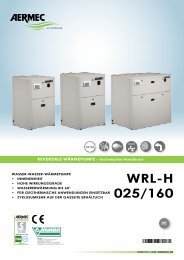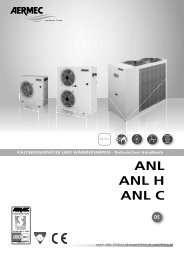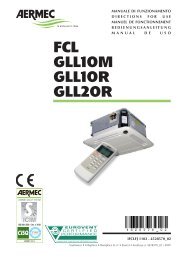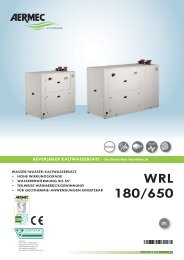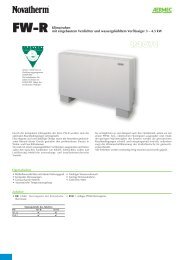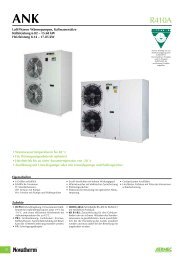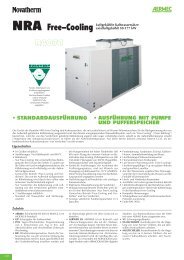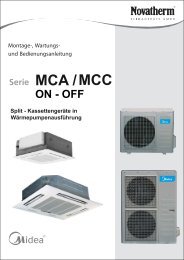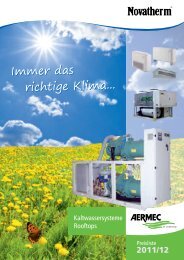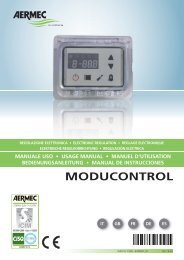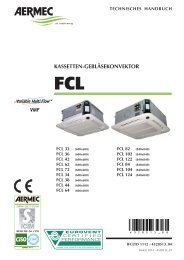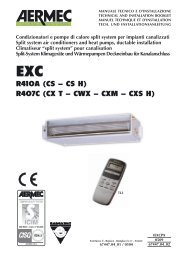GB - Novatherm Klimageräte GmbH
GB - Novatherm Klimageräte GmbH
GB - Novatherm Klimageräte GmbH
You also want an ePaper? Increase the reach of your titles
YUMPU automatically turns print PDFs into web optimized ePapers that Google loves.
<strong>GB</strong><br />
IMPORTANT MAINTENANCE INFORMATION<br />
The fancoil is connected to the power supply and a water circuit. Operations performed by persons without the required<br />
technical skills can lead to personal injury to the operator or damage to the unit and surrounding objects.<br />
POWER THE FANCOIL WITH SINGLE-PHASE 230 V ONLY<br />
Use of other power supplies could cause permanent damage to the fancoil.<br />
NEVER USE THE FANCOIL FOR APPLICATIONS FOR WHICH IT WAS NOT DESIGNED<br />
Do not use the fancoil in husbandry applications (e.g. incubation).<br />
AIR THE ROOM<br />
Periodically air the room in which the fancoil has been installed; this is particularly important if the room is occupied by<br />
many people, or if gas appliances or sources of odours are present.<br />
CORRECTLY ADJUST THE TEMPERATURE<br />
Room temperature should be regulated to ensure maximum comfort to persons present, particularly in the case of the<br />
elderly, infants and invalids. Prevent temperature fluctuations between indoors and outdoors greater than 7 °C during summer.<br />
Note that very low temperatures during summer will lead to greater electricity consumption.<br />
ORIENT AIR FLOW CORRECTLY<br />
Air delivered by the fancoil should not be oriented directly at people; even if air temperature is greater than room temperature,<br />
it can cause a cold sensation and consequently discomfort.<br />
DO NOT USE HOT WATER<br />
When cleaning the indoor unit, use rags or soft sponges soaked in warm water (no higher than 40°C).<br />
Do not use chemical products or solvents to clean any part of the fancoil.<br />
Do not splash water on interior or exterior surfaces of the fancoil; danger of short circuit.<br />
PERIODICALLY CLEAN THE FILTER<br />
Frequent cleaning of the filter will ensure more efficient unit operation.<br />
Check whether the filter requires cleaning; if it is particularly dirty, clean it more often.<br />
Clean the filter frequently. Use a vacuum cleaner to remove built up dust. Avoid water or detergents if possible since they<br />
greatly accelerate loss of the filter's electrostatic charge.<br />
After cleaning and drying the filter, fit it on the fancoil by following the removal procedure in reverse order.<br />
SPECIAL CLEANING<br />
The removable drip tray and fan volute ensure thorough cleaning of the unit (by specifically trained personnel), essential for<br />
installations in venues subject to crowding or in those with special hygiene requirements.<br />
DURING UNIT OPERATION<br />
Always leave the filter on the fancoil during operation (otherwise dust in the air could soil the surface of the coil).<br />
IT IS NORMAL<br />
During cooling, water vapour may be present in the air delivery.<br />
During heating operation a light rustling sound may be perceived near the fancoil.<br />
Sometimes the fancoil can give off unpleasant odours due to the accumulation of substances present in the room: air the<br />
room and clean the filter more often.<br />
OPERATING LIMITS<br />
Maximum water inlet temperature 80 °C<br />
Maximum working pressure 8 bar<br />
Minimum average water temperature<br />
To prevent the formation of condensation on the exterior of the unit while the fan is operating, the average water temperature<br />
should not drop beneath the limits shown in the table below, determined by the ambient conditions. These limits refer to<br />
unit operation with fan at minimum speed. Note that condensation may form on the exterior of the unit if cold water circulates<br />
through the coil while the fan is off for prolonged periods of time, so it is advisable to fit the additional three-way<br />
valve.<br />
MINIMUM AVERAGE WATER TEMPERATURE<br />
Dry bulb temperature °C<br />
21 23 25 27 29 31<br />
15 3 3 3 3 3 3<br />
17 3 3 3 3 3 3<br />
Wet bulb temperature °C 19 3 3 3 3 3 3<br />
21 6 5 4 3 3 3<br />
23 - 8 7 6 5 5<br />
10



